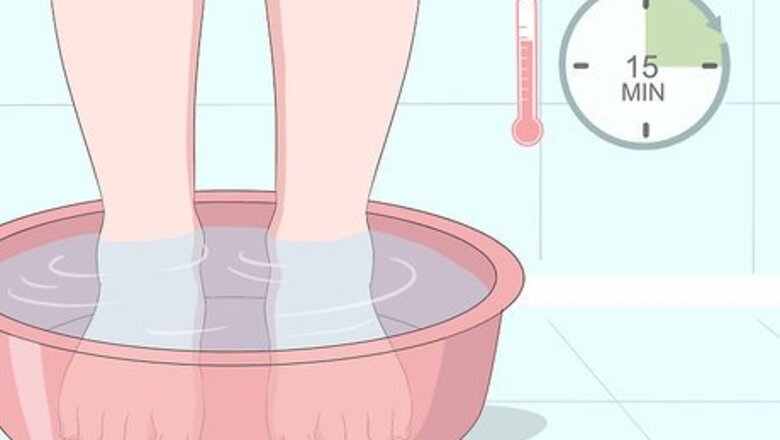
views
Trying Home Remedies

Soak your foot in warm water. Use a large bowl or your bathtub to soak your foot. This will help reduce swelling and tenderness. Soak it for about 15 minutes. Repeat 3-4 times per day until your nail has grown out. Add Epsom salts to the water. Epsom salts are widely recognized for their ability to reduce pain and swelling. These will also help soften the toenail. Try adding 3 tbsp (75 g) of Epsom salt to about 2 US qt (1.9 l) of warm water. If you don't have Epsom salts, you can use plain salt. Salt water will help reduce the growth of bacteria in the area. Gently massage the affected area. This will help water soak into the ingrown toenail, which will help clear out bacteria and may relieve swelling and pain.

Use cotton or floss to gently lift the nail edge. After you soak your foot, the toenail should be softened. Carefully work a piece of clean dental floss under the edge of your nail. Lift up the edge of the toenail gently so that it does not grow further into your skin. Try this approach after every foot soak. Use a clean length of floss each time. Depending on the extent of your ingrown toenail, this might be a little painful. Try taking a pain reliever to ease your discomfort. Don’t dig too much into your toenail. You can cause more infection, which may require medical intervention. Also, if you cut your toenail, don't rip at it or cause any bleeding, as that will cause more swelling in the area.

Take a pain reliever. An over-the-counter pain reliever can give you some relief from the discomfort you’re experiencing. Try a non-steroidal anti-inflammatory drug (NSAID) such as ibuprofen, naproxen, or aspirin. NSAIDs can help relieve pain and inflammation. If you cannot take NSAIDs, try acetaminophen instead.
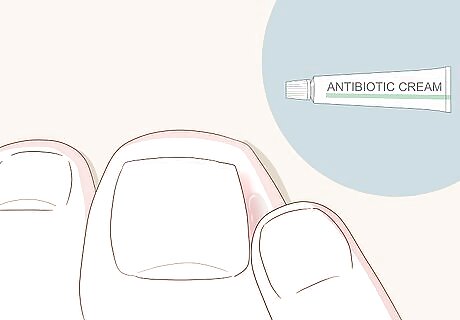
Try a topical antibiotic cream. An antibiotic cream will help fight off infection. This type of cream is readily available at drug stores and grocery stores. Antibiotic creams also can have topical anesthetic such as lidocaine. This will temporarily relieve the pain in the area. Follow application instructions on the cream’s package. Please be aware that topical antibiotics are difficult to accurately dose and there is also the possibility of local negative skin reactions. occurring

Bandage your toe to protect it. To protect your toe from getting further infected or caught on your sock, wrap a bandage or bit of gauze around your toe.

Wear open-toe sandals or loose shoes. Give your feet some extra room by choosing to wear open-toe shoes, sandals or other loose-fitting shoes. Tightly fitting shoes can cause or exacerbate an ingrown toenail.
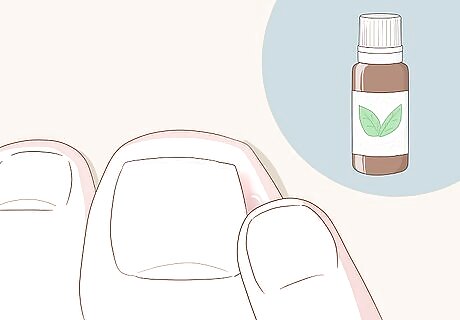
Try homeopathic remedies. Homeopathy is alternative medicine that relies on herbs and other natural ingredients to treat various ailments.To treat ingrown toenail pain, try one or more of the following homeopathic remedies: Silicea Terra, Teucrium, Nitric Acid, Graphites, Magnetis Polus Australis, Phosphoric Acid, Thuja, Causticum, Natrum Mur, Alumina, or Kali Carb.
Helping the Toenail Heal

Soak your feet for 15 minutes. Using warm water and Epsom salts, give your affected toenail a good soak for 15 minutes. This will help soften the nail, making it easier for you to pull it away from the skin.

Lift the toenail away from the skin. Gently pull away the skin alongside your toenail. This will help separate the skin from the nail so that you can see the edge of the nail. Use a piece of floss or a pointed file to lift the edge of the toenail away from the skin. You might need to start with the side of the toenail that is not ingrown. Work the floss or file toward the ingrown edge. Make sure to disinfect the file with alcohol or hydrogen peroxide before you use it.
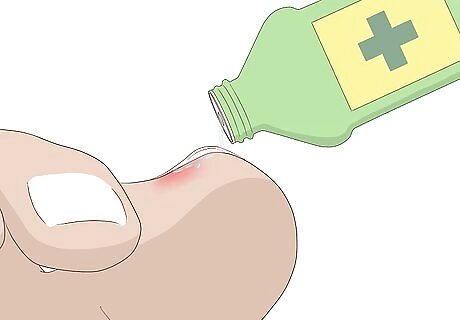
Disinfect your toe. While you have the nail lifted away from the skin, pour a small amount of clean water, rubbing alcohol, or other disinfectant underneath the nail. This will prevent bacteria from collecting there.
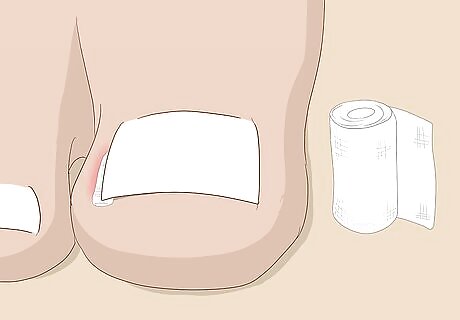
Pack gauze underneath the nail edge. Take a small amount of clean gauze and stuff it underneath the lifted nail. The point here is to keep the nail edge from touching the skin. Then it can grow away from the skin, rather than becoming more ingrown.
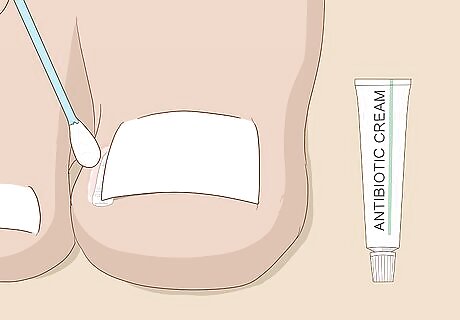
Dab antibiotic cream around the nail. Once you have gauze in place, dab the area with an antibiotic cream. You can choose an ointment with lidocaine, which will slightly numb the area.
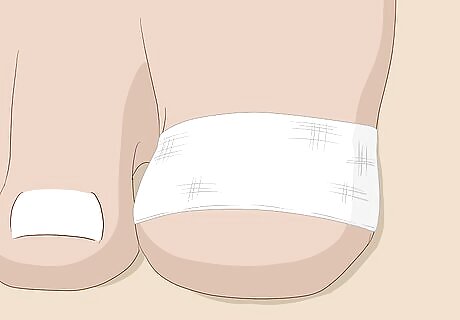
Bandage the toe. Wrap a strip of gauze around your toe. Or, you can use a bandage or a toe sock, which is a single toe covering designed to keep one toe separate from the others.

Repeat the process daily. Use this process to help heal an ingrown toenail. As the toe heals, the pain from the ingrown toenail will subside, and the swelling will go down. Be sure to change the gauze daily to ensure that bacteria is not introduced into the toenail area.
Seeking Professional Help
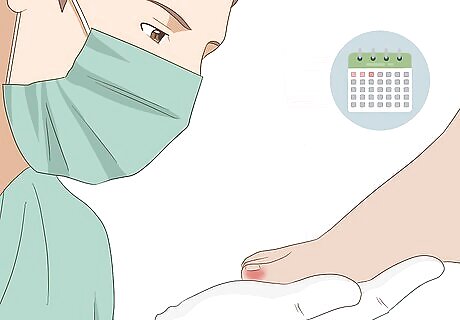
Get medical attention after 2-3 days. If your home treatments are not making your toenail any better after 2-3 days, check in with your doctor. If you have diabetes or another condition that causes nerve damage, see your doctor immediately and consider seeing a podiatrist. If you notice red streaks coming from the toe, you need to see a doctor immediately. This is a sign of a major infection. You should also see a doctor if there is pus present near the toenail.

Talk to your doctor about your symptoms. Your doctor will ask you when the ingrown toenail started, and when it started to swell or get red or painful. He or she will also likely ask you if you are feeling any other symptoms, such as fever. Be sure to talk about your symptoms fully. Your general practitioner is usually able to treat an ingrown toenail. But for more complicated cases or recurrent conditions, you might choose to see a podiatrist (foot specialist).
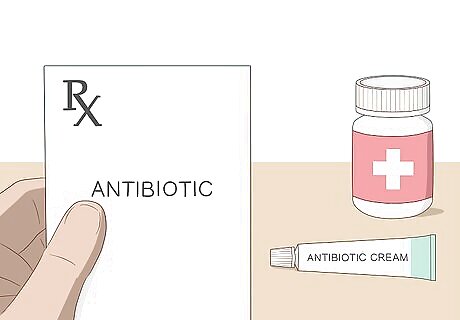
Get a prescription for antibiotics. If your toenail is infected, your doctor may prescribe an oral or topical antibiotic. This will ensure that the infection clears up and new bacteria does not take root under the toenail.
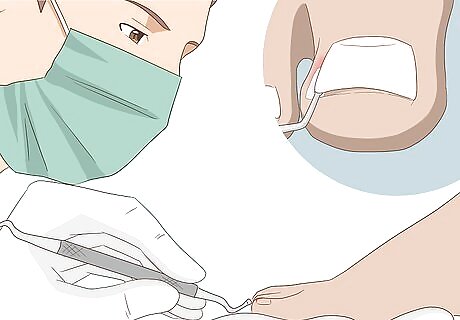
Allow your doctor to try lifting the toenail. Your doctor will likely want to try the least invasive procedure, which is to lift the toenail slightly away from the skin. If they can get the toenail edge away from the skin, they may pack gauze or cotton underneath. Your doctor will give you instructions for replacing the gauze every day. Follow these instructions to make sure your toenail heals.

Ask about partial nail removal. If the ingrown toenail is very infected or has grown significantly into the surrounding skin, your doctor might opt to remove part of the nail. Your doctor will administer a local anesthetic. Then the doctor will cut along the nail edge to remove the part of the nail growing into the skin. Your toenail will regrow in 2-4 months. Some patients worry about the look of the toenail after this procedure. But if your toenail has been growing into your skin, chances are it will look better after this partial removal. Toenail removal may sound drastic, but it actually relieves the pressure, irritation, and pain of an ingrown nail.

Look into permanent partial nail removal. When you get repeated ingrown toenails, you might want to look into a more permanent solution. In this procedure, the doctor will remove some of your nail, along with the nail bed underneath this section. This will prevent the nail from growing back in this area. This procedure is administered by laser, chemical, electrical current or other surgery.
Preventing Ingrown Toenails
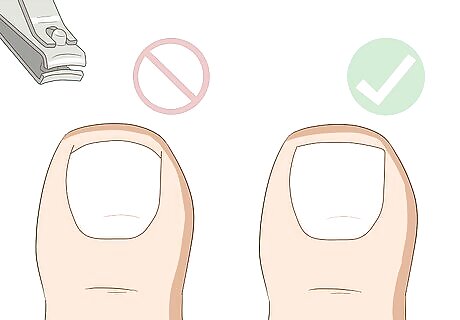
Trim your toenails properly. Many ingrown toenails are caused by improperly trimmed toenails. Cut your toenails straight across. Do not round the corners. Use sanitized nail clippers. Don’t cut your toenails too short. You can also opt to leave the toenail a little longer. This will ensure that the toenail won’t grow into the skin.

Visit a foot care clinic. If you are unable to reach your toenails to clip them yourself, you can visit a foot care clinic to get this service. Check with your local hospital or health care center to find a place that will trim your toenails regularly for you.
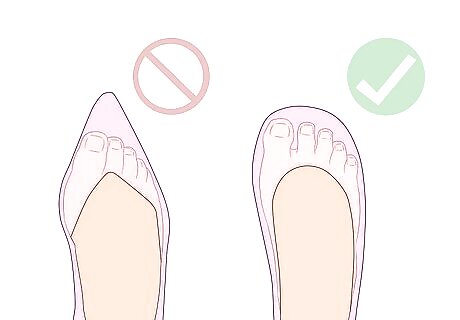
Avoid wearing tight-fitting shoes. If your shoes pinch your toes, you may put yourself at risk to develop ingrown toenails. The side of your shoe might press against your toe and cause your toenail to grow improperly.
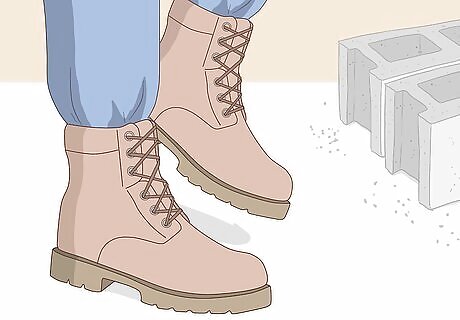
Protect your feet. If you engage in activities that could potentially injure your toes or feet, wear protective shoes. For example, wear steel-toed shoes on construction sites.
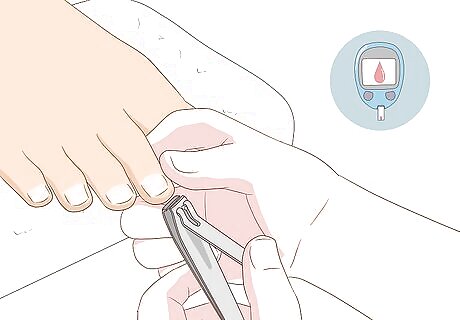
Get help with toenail care if you have diabetes. People with diabetes often have numbness in their feet. If you trim your own toenails, you may accidentally cut your toe and not feel it. Visit a foot care clinic or have someone else trim your toenails for you. You should also see your podiatrist regularly if you have diabetes or another condition that causes nerve damage.
Diagnosing an Ingrown Toenail
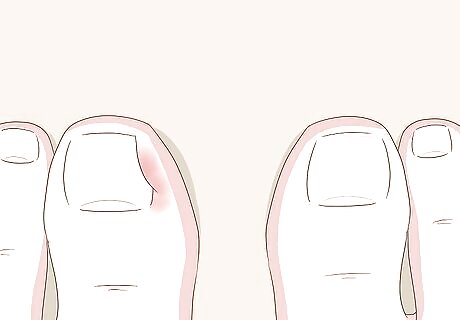
Check to see if there is swelling on your toe. An ingrown toenail will usually cause a small amount of swelling in the area next to your toenail. Compare your toe to the same toe on your other foot. Does it look puffier than normal?

Feel the area for pain or sensitivity. The skin around the toenail will feel tender, or painful when touched or pressed. Gently press your finger along the area to isolate where the discomfort is coming from or just take a nail clipper and cut off the nail. An ingrown toenail might also have a small amount of pus.

Check where the nail is. With an ingrown toenail, the skin alongside the edge of the nail appears to grow over the nail. Or, the nail might look like it’s growing underneath the skin alongside the nail. You might not be able to locate the top corner of the nail.

Take into account your health conditions. Most of the time, an ingrown toenail can be treated at home successfully. But if you have diabetes or another condition that causes neuropathy, or nerve damage, you should not try treating an ingrown toenail by yourself. You should make an appointment with your doctor immediately. If you have nerve damage or poor blood circulation in your leg or foot, your doctor will want to check out your ingrown toenail right away.
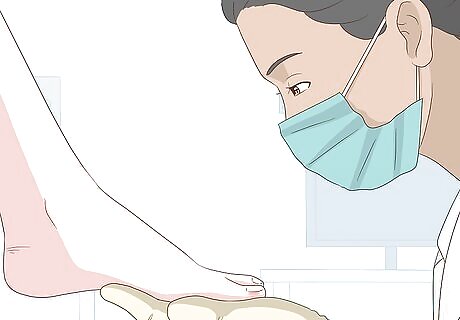
Talk with your doctor. If you’re not sure if you have an ingrown toenail, it’s best to see your doctor. She will be able to diagnose the toenail and give you recommendations for treating it. If the condition is particularly bad, your physician may recommend seeing a podiatrist, or foot specialist.

Don’t let your toe get worse. If you think that your toenail is ingrown, you should start treating it immediately. Otherwise, you risk letting it cause more serious problems like infection. If you have symptoms for more than 2-3 days, you should see a doctor.
















Comments
0 comment